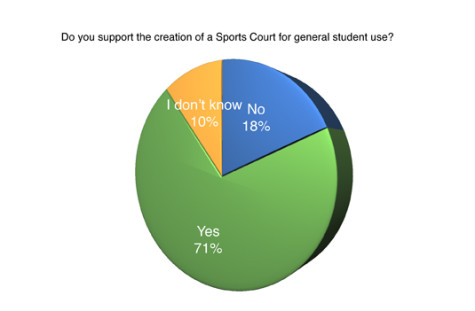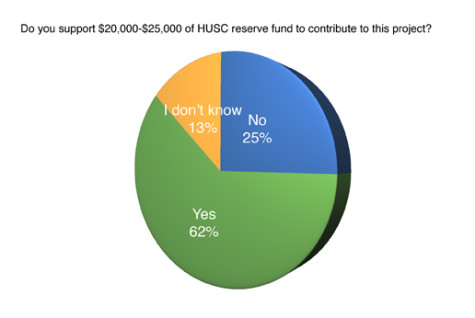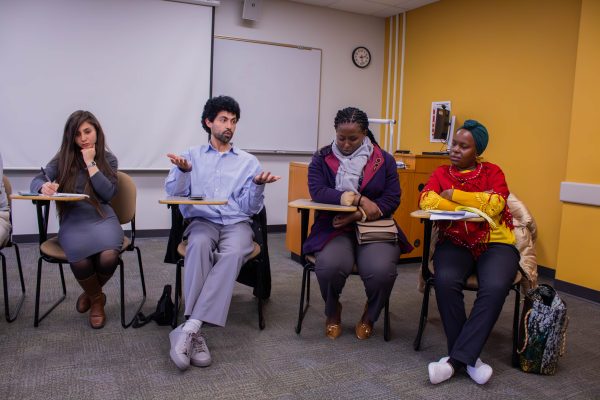Sports court in the works
HUSC is planning to donate funds to the university’s new sports court.
A negotiation team was authorized by the Hamline Undergraduate Student Congress (HUSC) at their General Assembly (GA) last Tuesday to donate up to $25,000 to a new sports court which is set to be built this summer.
The sports court would entail a multi-use, four season surface that could be utilized for volleyball, basketball and tennis during the warmer months. During the winter, its surface could be flooded and transformed into an ice rink. The proposed location is the parking lot between the law school and Manor Residence Hall.
The cost of the project would total $175,000, in which $100,000 would come out of the university’s capital improvement budget. Vice President for Development and Alumni Relations Tony Grundhauser is planning to raise $50,000 from alumni donations, and has secured half of that target already.
“He seemed very confident in their ability to reach that goal,” HUSC President Lucas Dolan said.
Grundhauser is asking alumni to make donations in honor of the former physical education professor, coach and athletic director Richard Mulkern, who the sports court will be named after. During his 29 years at Hamline, Mulkern coached 44 student All-Americans and was named Coach of the Year twice by the National Association of Intercollegiate Athletics (NAIA).
The $25,000 donation from HUSC would help to bridge the gap to reach the $175,000 mark.
According to Dolan, the idea for the sports court was originally proposed two years ago by Director of Campus Recreation Lamar Shingles, who saw a need for more recreational athletic facilities for students. When the 20-year campus master plan was developed in 2007, there wasn’t a campus recreation department on campus at the time; therefore, this kind of facility wasn’t considered a priority in the expansion and development of the university. “Since Lamar has been here, the program has grown immensely,” Dolan said “Now over 40 percent of Hamline students are involved in campus recreation.”
Dolan has served as the sole student representative on campus planning committees for the past two years. “I’ve seen the conversation develop,” he said. These committees vote and rank capital improvement projects in the priority they should be addressed. Their recommendations are then passed to the budget committee and Board of Trustees to be put to action. Last year, the sports court was ranked high on the list, but didn’t make the cut due to mandatory renovations to keep the university buildings up to code. This year, the sports court was on the edge of being included in capital improvements again.
“The idea came from the Provost [Eric Jensen] and Tony Grundhauser that they could raise money for it, and with our contribution it would be able to be built this summer,” Dolan explained.
On Monday, May 5, HUSC received a formal request for a donation from President Linda Hanson for the sports court. Normally, HUSC takes money out of its capital improvement fund for campus renovations. However, due to a clause in the bylaws that states the capital improvement funds cannot be accessed within in two weeks of April 30, and that there was only one GA left in the school year to complete business, Dolan had to be creative with a solution.
He proposed for the HUSC representatives to authorize a team composed of himself, current Vice President T. Corbin Conliffe, President elect Allissa Heim and Vice President elect Jenni Peredia to negotiate a donation up to $25,000 with the university from HUSC’s reserve funds.
At the GA, Dolan explained that before the donation is made, he wants to be sure the sports court will be used by students in campus recreation and that HUSC would be somehow be recognized for their donation with a plaque, for example. “I’d like to talk about more of the details, make sure we receive the maximum recognition and bang for our buck,” he said.
The reserve fund is designed to accumulate 20 percent of rollover funds each fiscal year to remedy extreme and unforeseen circumstances that threaten HUSC, and to rectify severe cash flow problems between July 1 and September 30 of any particular academic year. Currently, the reserve fund is sitting at $41,837.98.
“The long-term stability of HUSC is threatened by hoarding students’ money,” Dolan said at the GA. “I think that’s downright embarrassing for us—the amount of money that is just sitting in a bank account. This is one way to put it to good use.”
Secondly, in 2010, HUSC donated $21,000 from the reserve fund to the university to build the Anderson Center, which sets a precedent to withdraw money from the reserve fund.
After Dolan gave his proposal, various concerns were brought up at the GA about the sports court, resulting in a 40-minute long discussion.
“It’s absolutely absurd that you would consider or discuss taking $25,000 of the students’ money and donating it to the school to get some sports courts,” Senior Representative elect Don Allen said. “I don’t think this is in the bylaws of the constitution of HUSC. This is complying to the administration to be in good standing. This is not something that helps the students.”
Allen then went on to claim that the donation was a favor to the university.
“I understand politics. I understand how the system works. That’s all it is, and you can’t say it’s not,” he said.
Later in an interview, Dolan responded to Allen’s statement. “The only reason that this is being considered in the first place is through student support,” Dolan said. “This is something that a large majority of students want. It’s not like [President] Linda Hanson wants this for personal use.”
At the GA, Allen proposed putting out a survey to see if the sports court was something that students really wanted. Other HUSC representatives said that they could see the student need for this sort of athletic facility.
A lot of students really like the sports court idea. That’s a huge interest for the students and that’s something we could bring to campus that no other university around has. In a way it would be upping the standards at Hamline.
— Board of Elected Representatives Chair Jeremiah Osokpo
“A lot of students really like the sports court idea. That’s a huge interest for the students and that’s something we could bring to campus that no other university around has,” Board of Elected Representatives Chair Jeremiah Osokpo said. “In a way it would be upping the standards at Hamline.”
Student Athletic Advisory Committee Representative Rachel Usgaard agreed with Osokpo. “I can attest to the number of students that are in Hutton every single day. We kick a great number of kids off the court for practice,” she said. “I can attest that there are a wide variety of students that would want this and use this court.”
Concerns regarding parking, location of the court, maintenance and a vote to use the capital improvement fund over the reserve fund were also discussed.
“I don’t think students are going to care where we get the money from, just that it comes from somewhere and that the court is built,” Heim said. “The majority of people don’t know about the different funds. They’re just going to be like ‘HUSC gave us this money to build a sports court, thank you.’”
Senior Representative Alex Arana heavily advocated for the proposal during the meeting, criticizing the money that was spent on Dahlberg Memorial tree and the Anderson Center by the university. “Anderson Center was built around a dining service that really doesn’t serve the students that well, and the entire facilities are made for Aramark,” he said. “There are some decisions that haven’t been made well. This is not one of them.”
He also discouraged Allen’s previous remark that the donation was a favor to the university. “This is not a political favor. Linda Hanson can get this money from somewhere else. She is giving us opportunity to exhaust some funds that we’re not really using, and do what HUSC is supposed to do, which is provide capital improvements.”
No matter what fund the money came out of, Arana still wanted the proposal to pass. “If this fails I’m going to be very pissed about it. This is not a couch! This is something that is going to provide entertainment and fitness for a lot of students,” he said. “Let’s do it!”
This is not a couch! This is something that is going to provide entertainment and fitness for a lot of students. Let’s do it!
— Senior Representative Alex Arana
Economic Affairs Chair Greg Bueno voiced his frustration that he should have been included in the negotiation team and informed earlier about the proposal. Because the donation would be about a third of the annual budget, Bueno thought that he or Treasurer Stephen Lutz should be included in the negotiation team.
Heim and Public Relations Chair Rachel Marzahn agreed with Bueno that someone from the financial side should be included and motioned to include Lutz on the proposal, which was voted on and passed. Bueno then motioned to include himself on the proposal, which also passed. To approve the proposal, a four-fifths majority was needed. Twenty representatives who were present voted for the proposal, and only one voted against it.
Shortly after the negotiation team was passed, HUSC sent out a survey regarding the sports court to the entire student body. “We wanted to make an effort to receive and get a general sense of what people thought about the project,” Dolan said.
As of press time, 391 students had responded to the survey. Dolan read through every comment that students wrote, and said he appreciated the thoughtful responses.
The majority of the negative comments were based on misunderstandings of where the money was coming from or what other alternatives the money could be used for. “A lot of people were saying, ‘I don’t want my tuition to be raised to build this court.’ Or, ‘The money should be going to pay my professors,’ and things like that,” Dolan said.
Dolan explained the distinction between the university’s operating budget and capital budget. The operating budget provides services and salaries, whereas the capital budget is used to renovate buildings and build new projects.
“You can’t just take funds from the capital budget and put it into operating. It’s not really a possibility to just take this money and give to professors. That would require a much bigger change in the way the university structures its budget,” Dolan said.
As for the HUSC student fee, Dolan believes that many students did not understand that the rollover fund is an accumulation of 10 to 20 years of past student fees, and would not result in any increase in fees for them.
Other students said they would prefer to have the money go toward other improvements to buildings on campus. “I agree that is an important goal to renovate some of our buildings, that as one person said are ‘literally falling apart,’ but there was a misunderstanding of what $175,000 can actually do,” Dolan said.
He explained that another project being discussed by the committees he has served on, was to renovate the Sorin bathrooms, which would cost $500,000 alone. “It’s not a realistic comparison. It’s incredible how much the cost adds up when you’re doing things like that to these buildings.”
Another student concern that appeared in the comment section of the survey, which was also brought up at the GA, was the lack of parking already on campus; and that the sports court taking administrators’ parking spaces could result in an additional lack of parking. Dolan believes that most of the administrators who currently park in that lot will instead park in the Anderson Center garage. He also mentioned the plans for additional parking to be added around campus in the next few years.
Some of the people who responded “I don’t know” on the question regarding support of the sports court, said that their opinion depended on the proposed location. According to Dolan, this is the best possible location after discussions with the campus planning committee. If the sports court was placed near the athletic facilities at the north end of campus, it would send the wrong message that it was for athletes, when it is intentionally meant to be a non-athletic facility. If the sports court was located on the edge of campus, that would raise issues of security and monitoring the facility so that it was not being used by the community. Between the law school and Manor, the sports court would be in the center of campus and near the residence halls for general student use.
Overall, Dolan said that the survey reinforced his views of student support. “So far the results that we have have supported what I said in the meeting, and what some other members have said, that this has pretty robust support from students.”
Dolan is hoping that the sports court will change the culture around intramural sports on campus. Because athletic teams are constantly booking Walker Fieldhouse and Hutton Arena for practices and games, intramural sports are usually required to play after 9 p.m. The sports court would hopefully allow games to take place earlier in the day, so that commuter students could also participate instead of driving to campus late at night.
As donations for the sports court continue to come in, and the HUSC negotiation team meets with administration, the team will decide on a set amount to give to the university. “Our negotiating team will be able to continue to make decisions and consider input. We’re still gathering information,” Dolan said. “We haven’t made a final decision; we could still chose to donate zero [dollars] if we wanted to.”
Technology Coordinator Alex Kolyszko summed up the intentions for the sports court. “At the end of the day, students like it,” he said. “It has four seasons, adds more athletic facilities on campus, lets people be more active all year around. Students like it.”







